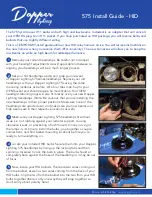
16. DETERMINATION OF
CAPACITY
a. A battery's capacity will, of course, decrease toward the
end of its life. Assuming no specific cause of trouble, this
will be a gradual decrease and ample warning of limiting
capacity will be evidenced by the slowing of the truck or
other vehicle toward the end of the day's work.
b. A battery is usually considered to be at the end of its
usefulness when its capacity decreases below 80% of
normal rating. However, it can sometimes be transferred to a
smaller job and thus give additional life and service.
18. WATERING
a. Use only approved water. That is 1) distilled water; or
2) de-mineralized water; or 3) local water that has been
approved for use in batteries. Never add acid, commercial
additives or other foreign material to the battery. Addition of
acid, commercial additives or foreign material may void
your warranty.
b. If there is some doubt as to whether the water being
used is suitable for use in lead-acid storage batteries, an
analysis should be obtained from a qualified laboratory,
otherwise, distilled or deionized water should be used.
Deionized water is available by using the EnerSys
PRO Clear Deionizer #94866.
c. Table 5 shows the maximum allowable impurities.
d. An EnerSys Watering Gun is a convenient and accurate
tool to aid in watering as it fills to a pre-selected height and
automatically shuts off; however, care must be taken to
adjust the watering gun so it will water cells to levels in
accordance with Figure 6.
c. Since the average motive power battery passes a “test”
every day by performing its regular work, it is seldom
necessary to conduct a formal test of its capacity. Also, most
users do not have the facilities to do this conveniently or
accurately. If any such testing is desired, consult your EnerSys
Representative regarding equipment and procedure.
17. TROUBLESHOOTING
The following conditions are usually indications of
approaching trouble.
*
Contact your local EnerSys Service Representative
CONDITION
CAUSE
SOLUTION *
Unequal or low specific gravities
a. Electrolyte spillage during watering
a. Avoid overwatering, neutralize & clean.
b. Electrolyte flooding
b. Water cells during end of charge.
c. Insufficient charge
c. Extend charging time.
d. Internal short
d. Replace cell.
Excessive water requirement
a. Overcharging
a. Select a properly sized charger.
Check charging time and average
battery temperature.
b. Jar leakage
b. Replace or repair cell.
Excessive cell temperatures
a. Overcharging
a. Check charger size and charging time.
b. Battery overworked
b. Reduce to one cycle/day or 300/year
maximum.
c. Battery being charged more than
c. Reduce charging to once per day.
once per day.
d. Battery temperature too high at
d. Allow battery to cool down before
start of charge.
starting charge.
e. Shorted cell(s)
e. Replace defective cell(s).
Poor truck performance
a. Battery undersized
a. Install higher capacity battery.
b. Undercharged battery
b. Extend charging time.
c. Discharge indicator malfunction
c. Reset discharge indicator for 80%.
d. Defective charging connector
d. Replace or repair cable and/or
connector.
e. Excessive loss of electrolyte
e. Adjust gravities at state of full charge.
Check for leakage.
7
Maximum
Allowable
Requirements
Limits
Total Solids*
350.0
Fixed Solids*
200.0
Parts
Organic and Volatile*
150.0
Iron
4.0
Per
Chloride
25.0
Ammonium (NH
4
)
5.0
Million
Nitrites (NO
2
)
10.0
Nitrates (NO
3
)
10.0
(P.P.M.)
Manganese
0.07
Calcium and Magnesium
40.0
TABLE 5 - WATER IMPURITY CHART
* ASTM Spec. D-1888-67 Method A, or equal.
TABLE 4 - TROUBLESHOOTING CHART





























